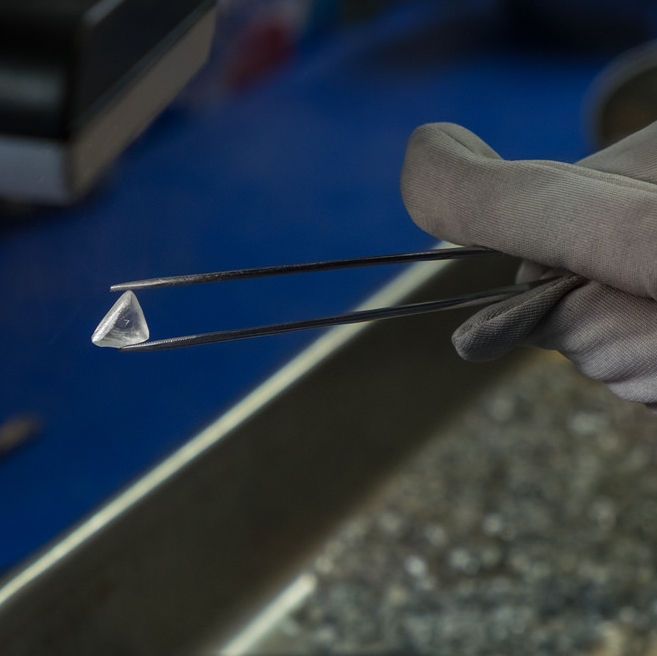Unique partnership and special diamonds

Two special gem-quality diamonds were discovered in recent weeks. They clocked in at 84.65 carat and 53.90 carat (not pictured). — Photo courtesy Moun
Two special gem-quality diamonds were discovered in recent weeks. They clocked in at 84.65 carat and 53.90 carat (not pictured). — Photo courtesy Mountain Province Diamonds
Exciting diamond discoveries are becoming the norm at Canada’s newest diamond mine. Earlier this summer, two special diamonds were uncovered at Gahcho Kué in the Northwest Territories. These diamonds were 84.65-carat and 53.90-carat gem-quality diamonds. They have already been sold to a manufacturer to soon appear on the public retail market.
Gahcho Kué is a joint venture between Mountain Province Diamonds (49 per cent) and De Beers (51 per cent). De Beers acts as the operator, running the day-to-day operations at the mine. “They bring their wealth of experience managing world-class deposits from around the globe to us at Gahcho Kué,” said Reid Mackie, vice-president of diamond marketing at Mountain Province Diamonds.
This particular joint venture differs from the other arrangements that De Beers has around the world. “We are the only instance I know of where a partner in a De Beers-run mine receives its interest in diamonds and sells them independently of De Beers on the open market,” Mackie said. This allows Mountain Province to develop its own marketing channels and campaigns that speak directly to specific consumers—especially in terms of authenticity and origin.
Mountain Province and De Beers have created a sophisticated system to split the diamonds fairly by value. This is most evident in the case of splitting the mine’s most valuable diamond category—the Fancies (fancy-coloured diamonds) and Specials (stones larger than 10.8 carats).
“With these diamonds, they are so rare that there is no homogeneity—no two are alike,” Mackie said.
The uniqueness and rarity of each Fancy or Special stone make it impossible to determine an equitable split of the category simply by weight. Instead, each company brings in a team of expert valuers from around the world to evaluate each stone individually and arrive at an independent valuation. “Each partner then bids against one another for the right to buy out the other partner’s share and then market 100 per cent of the stones independently,” said Mackie.
Mountain Province markets its share of rough diamonds through a separate sales channel to the open, rough diamond market. “With rough diamonds, because each stone is different, it’s a complex exercise that involves the creation of hundreds of individual lots,” Mackie said.
Mountain Province then sells these lots to its customers through an online, competitive bidding tender process in Antwerp, 10 times each year.
After a manufacturer wins a bid, the rough diamond still needs to be polished and set into jewelry before landing in a store. Typically, it takes about six to 12 months for a diamond to make its way through the entire process from discovery to a display case.
Mountain Province’s Gahcho Kué diamonds are expected to arrive on the retail jewelry market shortly, as production began a few months ago. A diamond mine typically takes about 10 years to reach production after discovery. A current goal is to ensure that the value attached to the diamonds’ Canadian origin is recognized through to retail.
“A few Canadian brands, such as Maple Leaf Diamonds, Arctic Love and Canadian Rocks, have taken an interest and are testing the product,” said Mackie. “The advantage with Mountain Province is that the parcels are not mixed with stones from anywhere else in the world. They are purely Canadian.”
The diamond market is currently trying to understand the diamonds that Gahcho Kué is producing. “The first year is a critical stage because it is when the market learns about the unique attributes of diamonds from a particular mine,” Mackie said. Specialist buyers are working on a stone-by-stone basis to understand the unique qualities of Gahcho Kué diamonds.
On the rare occasion that a new diamond mine is discovered, the “new” diamonds not only look differently, but behave differently for the craftspeople who cut and polish them. “These stones have been locked away for more than five million years, and we are the first people seeing them,” Mackie said. “This great responsibility is not lost on us and our buyers.” They need to know how each stone polishes, how the colours behave or if there are new characteristics present that haven’t been seen before. Essentially, they determine how to make the most of each rough diamond.
Fortunately for Mountain Province, the company has seen a steady flow of Special diamonds and also has seen a significant amount of D-coloured diamonds—the highest colour grade achievable for a white diamond. “This is rare in Canadian diamonds. The other mines here are not known for producing D colours,” said Mackie.
The predicted lifespan of Gahcho Kué is another indicator of its strong potential for success. The current reserve estimates predict mining for 12 years; the resource estimates show potential for up to 20 years.
“When buyers look at Mountain Province, not only do they see a large volume mine that is Canadian, but they also see that it has potential to be around for up to 20 years,” Mackie said. When considering whether or not to take a position in buying from a new mine, buyers take note of both the quality of diamonds and the number of years they can expect a supply.
Gahcho Kué is recognized around the world as the most important diamond discovery to come onstream in quite some time.
“Now (the company) is out on the market making a name for itself and Canadian diamonds,” Mackie said. “I would expect that on the back of this success and the other Canadian productions that have come before us, we will see continued interest in Canadian diamonds and further exploration in Canada.”
Mountain Province Diamonds is currently pouring its entire focus into taking full advantage of the opportunities that Gahcho Kué’s diamonds present. The goal is to firmly establish the company’s long-term success based upon this important diamond source.




